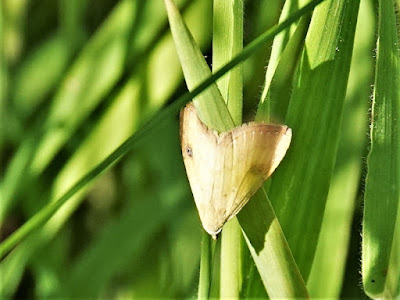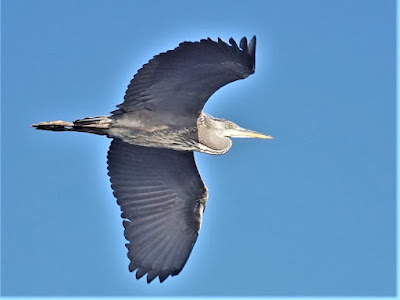10.0°C > 18.0°C: Wall-to-wall clear skies. Light and variable breezes. Very good visibility. Much fresher.
Sunrise: 04:46 BST yet again
* = a photo of this species today
Priorslee Balancing Lake: 05:05 – 06:15 // 07:15 – 09:40
(126th visit of the year)
Bird notes:
- Again just one adult Mute Swan emerged briefly from around the hidden nest site.
- The Cetti's Warbler was uncharacteristically muted this morning. It was over an hour before I heard it. Later it was much more intermittently assailing my ear-drums.
- The Sedge Warbler was still singing lustily from its new location first thing but then disappeared in to the East end scrub where it, or another, sang throughout May.
- I counted 39 Starlings on the football field at 06:05
- My first Grey Wagtail for several weeks: a juvenile amongst the juvenile Pied Wagtails around the boat launching area.
Birds noted flying over here:
- 2 Greylag Geese: outbound together
- 1 Stock Dove
- 27 Wood Pigeons
- 6 Black-headed Gulls: very high overhead together
- 1 Lesser Black-backed Gull
- 7 Jackdaws
- 1 Rook
Warblers noted (the number singing in brackets):
- 1 (1) Cetti's Warbler
- 1 (1) Willow Warbler
- 10 (10) Chiffchaffs
- 1 (1) Sedge Warbler
- *11 (9) Reed Warblers
- 13 (13) Blackcaps
- 2 (2) Garden Warblers
- 1 (1) Common Whitethroat
Hirundines etc., noted:
- 4 Swift
- 2 Barn Swallow
- House Martins heard only
Counts from the lake area: it remains very quiet
- 1 Mute Swan only seen
- 2 (1♂) Mallard
- 2 Moorhens
- 34 + 31 (12 broods) Coots
- 12 + 4 (1 brood) Great Crested Grebes
- *1 Grey Heron: departed
+ = my first sighting of this species here this year.
++ = new species for me at this site.
Noted on and around the street lamp poles around dawn:
- *1 Common Green Lacewing (Chrysoperia carnea)
Noted later:
The total number of insects remains low. A reasonable number of 'first for the year' today.
Butterflies:
- +*Large Skipper (Ochlodes sylvanus)
- Speckled Wood (Pararge aegeria)
- +*Meadow Brown (Maniola jurtina)
- *Red Admiral (Vanessa atalanta)
- +*Large Skipper (Ochlodes sylvanus)
- Speckled Wood (Pararge aegeria)
- +*Meadow Brown (Maniola jurtina)
- *Red Admiral (Vanessa atalanta)
Moths:
- Timothy Tortrix (Zelotherses paleana)
- Blood-vein (Timandra comae)
- Silver-ground Carpet (Xanthorhoe montanata)
- +*Latticed Heath (Chiasmia clathrata)
- +*Burnet Companion (Euclidia glyphica)
- *Straw Dot (Rivula sericealis)
- Timothy Tortrix (Zelotherses paleana)
- Blood-vein (Timandra comae)
- Silver-ground Carpet (Xanthorhoe montanata)
- +*Latticed Heath (Chiasmia clathrata)
- +*Burnet Companion (Euclidia glyphica)
- *Straw Dot (Rivula sericealis)
Bees / wasps etc.:
- Garden Bumblebee (Bombus hortorum)
-. Tree Bumblebee (Bombus hypnorum)
- Early Bumblebee (Bombus pratorum)
- Common Wasp (Paravespula vulgaris)
- Garden Bumblebee (Bombus hortorum)
-. Tree Bumblebee (Bombus hypnorum)
- Early Bumblebee (Bombus pratorum)
- Common Wasp (Paravespula vulgaris)
Dragon-/damsel-flies:
- unidentified 'pale' (immature) dragonfly flushed
- Common Blue Damselfly (Enallagma cyathigerum)
- *Red-eyed Damselfly (Erythromma najas)
- Blue-tailed Damselfly (Ischnura elegans)
- +*Black-tailed Skimmer (Orthetrum cancellatum)
- unidentified 'pale' (immature) dragonfly flushed
- Common Blue Damselfly (Enallagma cyathigerum)
- *Red-eyed Damselfly (Erythromma najas)
- Blue-tailed Damselfly (Ischnura elegans)
- +*Black-tailed Skimmer (Orthetrum cancellatum)
Hoverflies:
- Marmalade Hoverfly (Episyrphus balteatus)
- *Stripe-faced Dronefly (Eristalis nemorum) [previously E. interruptus]
- Common Dronefly (Eristalis tenax)
- Common Spotted Field Syrph (Eupeodes luniger)
- Syrphus sp. (S. ribesii / S. vitripennis)
- Marmalade Hoverfly (Episyrphus balteatus)
- *Stripe-faced Dronefly (Eristalis nemorum) [previously E. interruptus]
- Common Dronefly (Eristalis tenax)
- Common Spotted Field Syrph (Eupeodes luniger)
- Syrphus sp. (S. ribesii / S. vitripennis)
Other flies:
- Black Snipefly (Chrysopilus cristatus)
- Yellow Dung Fly (Scathophaga stercoraria)
- *plumed midge sp.
- Black Snipefly (Chrysopilus cristatus)
- Yellow Dung Fly (Scathophaga stercoraria)
- *plumed midge sp.
Beetles:
- Swollen-thighed Beetle (Oedemera nobilis)
- Swollen-thighed Beetle (Oedemera nobilis)
Bugs:
- +*7 Spot Ladybird (Coccinella 7-punctata)
- Dock Bug (Coreus marginatus)
- +*7 Spot Ladybird (Coccinella 7-punctata)
- Dock Bug (Coreus marginatus)
Also
- White-lipped Snail (Cepaea hortensis)
- Cucumber Green Orb Spider (possibly Araniella cucurbitina)
- stretch spider Tetragnatha sp.
- *unidentified spider sp.
- White-lipped Snail (Cepaea hortensis)
- Cucumber Green Orb Spider (possibly Araniella cucurbitina)
- stretch spider Tetragnatha sp.
- *unidentified spider sp.
A calm, clear start: the few ripples on the water were caused by spawning fish thrashing about.
A Grey Heron maintains a lonely vigil.
This seems to be the only Reed Warbler prepared to show itself. Not easy to persuade the camera to focus on the bird and not the vegetation.
Likes to hide though.
Many of the insects were very flighty today: my best shot of my first Large Skipper butterfly (Ochlodes sylvanus) of the year. Separate from the similar (and similar-sized, despite its name) Small Skipper (Thymelicus sylvestris) by the shading around the wing-edge.
My first Meadow Brown butterfly (Maniola jurtina) of the year confusingly sitting with its fore-wing retracted and thereby obscuring the diagnostic white-centred black circle in the wing. I normally see this species some days after my first Ringlet (Aphantopus hyperantus) though I note I saw my first of both species last year on 17 June.
At last: a Red Admiral (Vanessa atalanta) that had the decency to stick around for a photo. This camera seems better able to render the red colour, though it is still not quite right.
This attractive Latticed Heath moth (Chiasmia clathrata) was determined to hide in the grass. I need to find another for a better photo. "Why is it a moth and not a butterfly?" I hear you ask. Butterflies have clubbed antennae: moths don't.
Another moth I am going to have to work on is this Burnet Companion (Euclidia glyphica). This one sitting awkwardly half in the shade and with its right fore-wing spread showing one under-wing. So-named as it flies at the same time as and in the same habitat as several burnet moths though it is some years since I noted any of these here.
A Straw Dot moth (Rivula sericealis). This species is very similar in colour to and only slightly larger than the Timothy Tortrix (Zelotherses paleana). Straw Dot typically rests head-down: Timothy Tortrix head up.
A freshly-emerged Red-eyed Damselfly (Erythromma najas). That may be its exuvia bottom right. At this age it cannot be sexed: the males become blue; the females green. Apart from the red eye (paler on immatures) recognise by the solid dark top to the thorax. Also the short dark mark on the side of the thorax.
And here is an adult male.
My first Black-tailed Skimmer dragonfly (Orthetrum cancellatum) of the year. This species likes to rest on bare ground, probably to warm up. There is a somewhat similar species – Broad-bodied Chaser (Libellula depressa) – which shows extensive dark at the base of the wings and, on fresh males, yellow spotting along the flanks.
Another 'new for the year'. It is a female Stripe-faced Dronefly (Eristalis nemorum), a smaller member of the drone fly group. This species typically shows the narrow pale bands on the abdomen and only a hint of brown markings at the very top. The face is not visible here, sadly.
I think I have photographed one of these before. Hanging upside down under a leaf is a tiny plumed midge. It is pointing left with its tail hooked up. The plumed antennae look as it they could sweep chimneys in dolls' houses.
This 7 Spot Ladybird (Coccinella 7-punctata) is, surprisingly, my first ladybird this year.
It is a relief to find something still on the street lamp poles when I arrived even if it is only a Common Green Lacewing (Chrysoperia carnea).
A spider: no idea about the species. It has some of the gait of a crab spider but I think that is because it is carrying an egg sac. It also seems too large for most species of crab spider.
Plane of the day. The Air Ambulance again, here on its second transit of the morning toward PRH. It is based on a dedicated helipad inside Cosford Aerodrome.
(Ed Wilson)
------------------------------------------------------------------------------------------------------
The Flash: 06:20 – 07:10
(116th visit of the year)
Bird notes:
- No Great Crested Grebes were noted after my note yesterday that both pairs were without any juveniles. Nests presumably failed..
Birds noted flying over here:
- *1 Grey Heron
- 1 Sparrowhawk
Warblers noted (the number singing in brackets):
- 7 (7) Chiffchaffs
- 3 (3) Blackcaps
Hirundines etc., noted:
- 5 Swifts
- 2 House Martins
Noted on / around the water
- 151 Canada Geese
- 24 Greylag Geese
- 2 + 4 Mute Swans
- 20 (17♂) Mallard
- no all-white duck (Peking(?) Duck)
- 11 (7♂) Tufted Duck
- 3 Moorhens only
- 24+ 5 (3 broods) Coots
- no Great Crested Grebes
Noted on / around the street lamp poles around the water:
- *Common Swift moth (Korscheltellus lupulina)
- *Spruce Carpet moth (Thera britannica)
- *May Highflyer moth (Hydriomena impluviata)
Elsewhere:
Nothing noted
A magnificent beast unless you are a fish or a frog. A Grey Heron flies over.
A Common Swift moth (Korscheltellus lupulina). The scientific name was Hepialus lupulinus. When the genus was changed the sex of the species name had to change. Whoever proposes a genus name declares whether the name is male or female and the species name has to be declined accordingly. Had I studied classics at school I would be able to tell you which species name is male and which female. The scientific name of course applies to the whole population, whether male or female. We are all Homo sapiens.
Sitting very awkwardly at the top of the tallest street lamp pole and surrounded by branches and leaves was this Spruce Carpet moth (Thera britannica).
Same lamp pole but a different specimen in a very different position, this time on the lamp over-hang. My second May Highflyer moth (Hydriomena impluviata) of the year.
(Ed Wilson)
Sightings from previous years without links are below
2013
Priorslee Lake
Richardson's-type Canada Goose
(Ed Wilson)
2012
Priorslee Lake
Sedge Warbler possibly breeding
Skylark nesting in Celestica grounds
(John Isherwood)
(Ed Wilson)
------------------------------------------------------------------------------------------------------
On this day can be found via the yearly links in the right-hand column.
Sightings from previous years without links are below
2013
Priorslee Lake
Richardson's-type Canada Goose
(Ed Wilson)
2012
Priorslee Lake
Sedge Warbler possibly breeding
Skylark nesting in Celestica grounds
(John Isherwood)






















